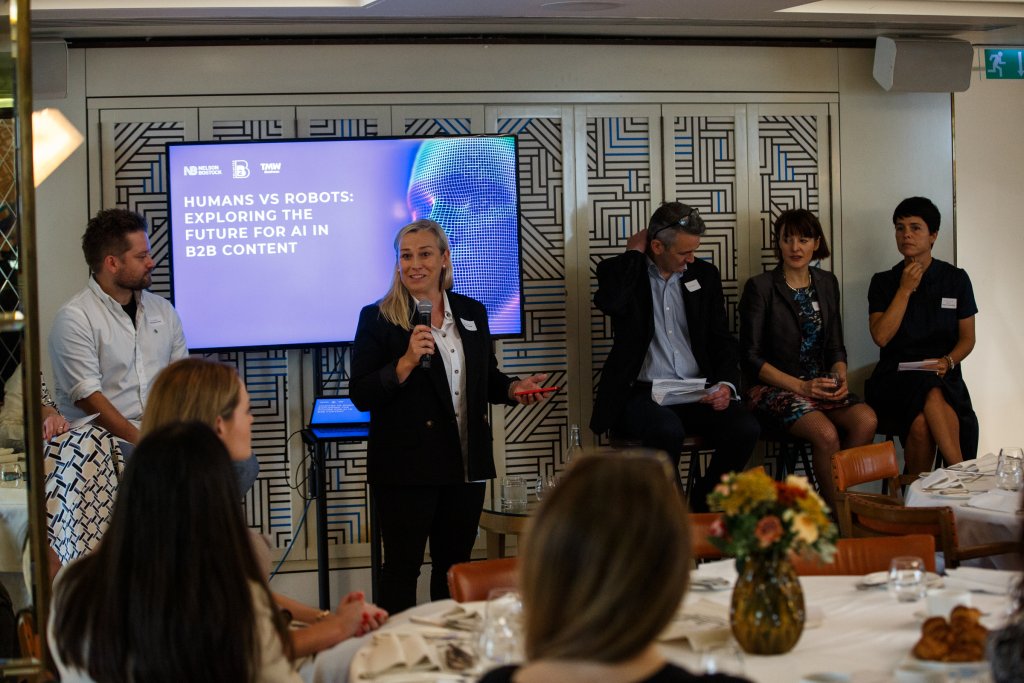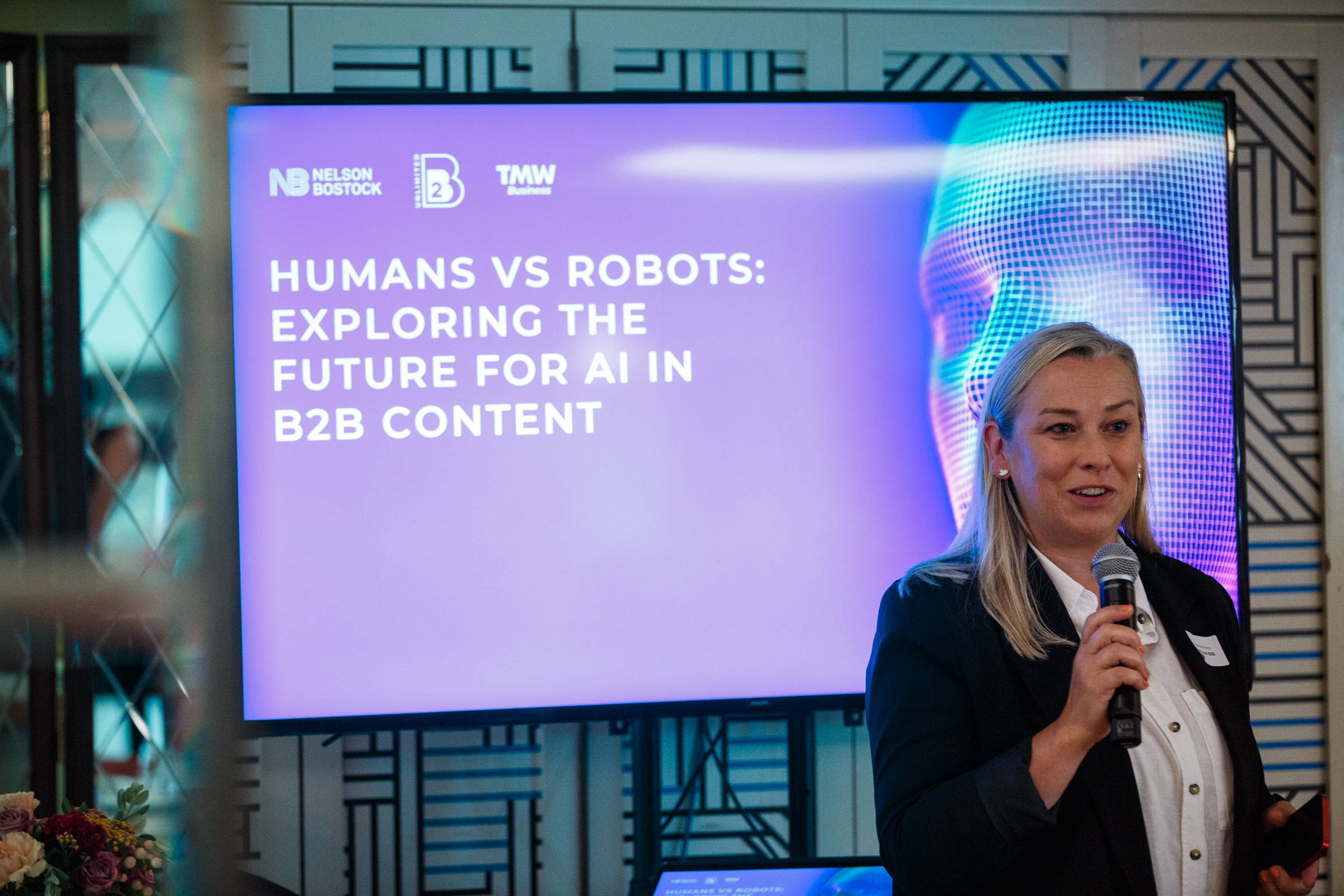An overwhelming show of hands closed out our AI event. Host Martin Veitch had asked the room of assembled B2B marketers to raise them if they had started to introduce generative AI tools at work. When he asked the opposite - if anyone was planning on steering clear - all hands remained in laps.
Clearly, AI is more than just a news story. Unlike the Metaverse, tech’s last big ‘disruptor’, AI is actually in use, now, by real people doing real work. Its adoption is only going to accelerate, but brands aren’t uniformly confident about how to proceed.
As more AI tools are launched, and campaigns like WWF’s AI-generated Future of Nature make headlines, B2B brands are left wondering what they should be doing, what they need to know, and what pitfalls they need to avoid.
Unlimited B2B hosted an event to discuss just that. Our panel was composed of UNLIMITED’s technical director Tom Wilks, the antagonist speaking on behalf of the robots, while neuroscientist Dr Cristina de Balanzo from the Human Understanding Lab argued for the ongoing benefits of the human touch. They were joined by Susi O’Neill from Kaspersky, and Cristina Tudorascu from Canon Europe, in a panel moderated by acclaimed tech journalist Martin Veitch.

The fast-paced discussion lasted for an hour and a half, and generated lively interactions from the gathered B2B professionals. For those who couldn’t make it, or those who want to reminisce, here are five of the key takeaways:
Brands Have Started Experimenting
Along with contributions from several attendees on the floor - who are already using SEO-driven content for websites, and adopting tools like Copilot for Microsoft Office 365 - we heard from panellists about the progress they’ve made so far in implementing AI tools.
“When it comes to content creation at Canon Europe, we have already started to incorporate AI technology as part of our content journey,” said Cristina Tudorascu. She spoke about how the company has introduced both a translation AI tool, and a voice-to-text generator to capture insights from SMEs in the business.
Neither, she pointed out, are perfect. “The system is still struggling with some elements that are quite important for us - like people’s names, product names - and there is a little bit of difficulty around different accents.”
These initial struggles aren’t putting them off from expanding their AI toolkit, though.“We understand that this is only a little bit of AI technology that we’re currently using, but this is the first step - and we’re looking forward to understanding even more, and making these tools work for us even better.”
The Compliance Question is Looming
One term in particular seemed to haunt the discussion: compliance. Never mind what AI can do - how useful is it? What can brands actually, legally, use it for? How does copyright work? What do lawsuits like those being waged by Getty Images against Stability AI, and Sarah Silverman against OpenAI mean for the use of AI in branded materials? Is there any such thing as brand safety with generation AI?
“Technology is moving much faster than regulation,” said Susi O’Neill. “It’s a totally grey area.”
Brands have to balance the potential risk against the possible reward. She went on to add that, “right now, if you’re using generative AI, even if you’re taking those images and manipulating them, changing them, you don’t own the copyright on that. So it’s about where you are on your journey.”
And this ‘risk versus reward’ debate looks very different for businesses of different sizes - especially given the limitations of AI creativity. “I don’t want to feed out a content mine of a trillion different formulaic pieces of information that have already been covered. For me, generative AI isn’t going to generate anything new that’s worthy of an award.”
“If you need to scale, and you don’t have very much legal risk - say you’re a start-up, or you work with very niche audiences - maybe it’s fine to go ahead. But if you’re a big corporate, you’re taking on a lot of legal risks. Now is maybe not the right time.”
Collaboration is Key
Good news for creatives - most attendees were in agreement that while AI is likely to be useful for undertaking menial tasks (like transcribing event recordings, for example), it can’t generate truly creative ideas. At least - not yet.
What it does have is “66 billion different data points, able to be retrieved within seconds.” Tom Wilks pointed out how AI “can democratise access to technology. You don’t have to figure out the best way to search any more, you type the question however you want it - and you’ll still get the information back.”
Finding the right question, or prompt, is likely to become an incredibly valuable skill, and one developed entirely in response to the rise of AI tools: prompt engineering. Dr Cristina de Balanzo spoke about the importance of human insight to this role, and explained how “the power of context will massively influence decision-making.” The context within which a question is asked is vital to getting the correct answer. This, she explained, is something AI tools - which function “more like a two-and-a-half year old” - don’t have.
What they can do, however, is provide a starting point. Susi O’Neill explained, “If you’re a business and you can’t hire the best talent, say you don’t have the best budgets, can you use prompt engineering to get to certain styles with the right kind of training? Yes - but you still need that human edge. You still need those senior writers and creatives to twist things and say ‘that word isn’t quite right’, or ‘that doesn’t sit well in the advert’, ‘that works in one language, but in another is not quite edgy enough’.”
“It’s about using the tools that are out there when we have gaps in resourcing or can’t hire the best people to get us a bit further along.” If that thought still fills you with dread - you’re not alone. Our resistance to fully embracing AI isn’t particularly unexpected, according to Dr Cristina de Balanzo. “Human beings are very resistant to change, because it’s physiologically painful - but if machines can do the jobs that we don’t want to do, they can make life better,” she explained.
Beware the ‘Brain Drain’
Working together with AI to check its work and build on its foundations seemed a popular approach amongst attendees, who largely agreed that AI could be put to good use in creating first-draft content, or providing a starting point for a human to then adapt, edit and improve.
But Susi O’Neill warned that, if we allow AI to take the position of entry-level creatives, the industry could soon find itself with a lot of high-level workers and nobody rising up to replace them.
She explained, “You need junior writers to learn from the seniors, and be able to build up their craft. When I see some of the first passes of ChatGPT, it reminds me of the junior writers I’ve worked with. It’s no worse - but it’s also no better. We still need people to come into our industries who are going to learn crafts and learn how to improve. But potentially, some of those roles are the ones which may be made redundant.”
AI is Only Young
Given the vast impact AI has already had on the market, you might be forgiven for forgetting that it’s still a young technology. Every day, new tools are released, and those that exist become smarter and smarter.
According to Tom Wilks, we haven’t even started to touch on the full range of AI’s capabilities. Soon, he said, AI will even learn to mimic human creativity - which he was confident will happen “probably quicker than most people expect it to. In some creative mediums, we’re already pretty close to being there.”
“The scale and the scope of what we are on the cusp of being able to achieve is unlike anything we’ve been able to see before,” he said. “We have to be open to the point that we may not be the top intelligence on the planet in some of these areas for much longer.”
One thing that all of the experts could agree on was the fact that AI is here to stay - and it’s us humans who’ll have to adapt to deal with it. But whether that’s by creating and implementing robust data protection and copyright policies, or via the creation of entirely new roles (such as prompt engineering), the road to embracing AI will be far from smooth and straightforward.
And it’s only just begun. Martin kicked off our session by reminding attendees that ChatGPT has only been live since November 2022. In just shy of eight months, it has already upended the way many B2B brands think about content creation.
What developments could the next eight months see?
To derive the most value from an AI-powered future, B2B brands must establish clear guidelines for when, and how, to use AI tools - and when to revert back to the human element.
Watch out for our event recording, coming soon!

No comments.